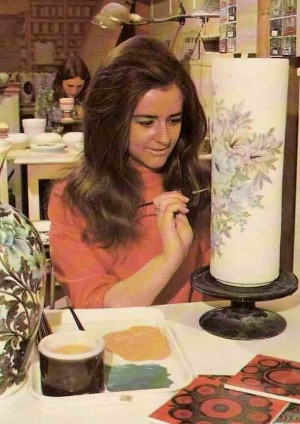It was in a bar in New York that I first realised how far Jersey reaches out to many parts of the world. The bar was one of those crazy Ye Olde Englishe Pubs with waiters dressed in ridiculous hunting outfits - and the ashtrays were from the Jersey Pottery.
Two days later at the World's Fair I stopped to have a drink in the real English pub on show there. I turned over an ashtray advertising Courage and Barclay's Beer to find they too bore the stamp: "Jersey Pottery, CI" So popular were these with the Americans that the pub went through 500 in less than a month - and even the chairman of Courage and Barclays had to send an SOS to Gorey to have one made for him.
Worldwide orders
I asked the owner of the Jersey Pottery, Mr Clive Jones, just how far abroad he sent pottery made in Gorey. "It goes all over the world" he said. "We have regular orders from places like Kuwait, the Philippines, Peru, and Canada - anywhere you can think of". That day he had received a letter from Tenerife addressed to Mr Clive Gorey, Jersey.
The success story of the Jersey Pottery is a remarkable one and there are few people in the island who know the extent of the business or who have ever been into the Potteries. This is a pity because it really is an eye-opener.
The Pottery started in 1946 at a time when English decorated ware was not permitted to be produced for home consumption, but solely for the export market. This policy did not apply to Jersey and the Pottery began to produce colourful decorated fancy ware such as cruets, and vinegar and oil bottles boldly decorated in gold and enamel. These were snapped up by people in England seeking colour for their homes after the utility years of the war and just after.
By 1950 however this lucrative market had come to an end. Increasing tariffs abroad, and the release in England of home produced fancy goods, had a telling effect on the fortunes of the Pottery and by the end of 1954 production had been drastically reduced and the staff consisted of only eight.
Debts eliminated
But before the light went out completely Clive Jones, then a young stockbroker who had been in the island since 1935, bought the company lock, stock and barrel for £5,500. He and his wife then set about completely reshaping the activities of the company. In a year they had wiped off the debts of four years and made a profit of £112.
They reshaped their policy around the tourist. "We decided that half a million people annually visiting the island we had a captive and transient population with a desire to take home something produced on the island as a permanent reminder of their visit to Jersey," said Mr Jones.
So they replanned the Pottery to bring visitors right into the works to watch craftsmanship pottery being made in all its stages of production - the clay being thrown, cast, fettled, decorated, glazed and finally fired in the kiln.
"We set out deliberately to make the visitors feel as if they were, in fact, part of the operation. The movement of traffic was so arranged that visitors finished their progress through the works in the showroom where the goods could be purchased" he said. "By making this direct approach it was possible to attain a lower cost level by the simple mathematics of eliminating costs of transportation, agents' fees and retailers' overheads".
New designs
New designs had then to be created and production was stepped up to meet the demand. Highly skilled craftsmen in design and mould-making were brought in from Stoke-on-Trent and a thrower was obtained from one of the Devon potteries. Up-to-date modern equipment was installed. And by 1959 the company was well on its feet again.
"It was then that we took stock and planned for future development," said Mr Jones. "I had a vision of the Pottery being set in a garden with trees and hundreds of rose bushes and flowers, pools and playing fountains. I saw all this against the backdrop of undulating farmlands and Mont Orgueil Castle and knew it could become a wonderful attraction."
The company acquired four acres of farmland from the Crown, on lease, to extend and modernise their buildings and provide adequate parking space for the busloads of tourists who were visiting the Pottery. This vision is now a reality, for rose bushes have been growing for five years and the Pottery has become a major attraction for tourists. Last year over a quarter of a million visitors saw the craftsmen at work on all stages of production in comfortable, airy surroundings. And it has established itself as one of the major industries of the island, maintaining a staff of approximately 50 all the year round.
Production has increased from the use of 30 tons of raw material in 1959 to 100 tons last year, of two different types of prepared clays, and this material is used in the sixty designs of utility and fancy lines at the moment being produced in all shapes and sizes from ashtrays to posy bowls, large vases and coffee sets.
Production
The products of the Pottery have, over a short span of time, developed a style and technique that has about it a feeling of difference. The chief designer, described by Mr Jones as "a brilliant young man with two travelling scholarships and a diploma of distinction to his credit", works with a team of 12 decorators, including Continental artists. Once the designer has produced his designs they go before the board, which consists of Mr and Mrs Jones and their daughter, 28-year-old Carol and 25-year-old son Colin, who is works manager. "This is when the battles begin," said Mr Jones with a smile. "We have a good struggle lasting about four days before deciding on designs.
Once the designs have been agreed the decorators interpret the basic designs in their own individual style, which ensures that each piece is individual in character. This individual licence in design, together with an all round high standard of craftsmanship, has created a world-wide demand for Jersey Pottery.
Every year a little more development is initiated. 1964 saw the building of an annexe to the showroom to house two new sections for making basketwork and Bondaglass jewellery. Visitors can now also watch the thrower and mould maker at work. And only recently they opened a new modern showroom on the corner of Bond Street and Mulcaster Street.
What of the future? Has the Jersey Pottery reached its peak of development? "I like to think it has," said Mr Jones. "I don't want it to get any bigger, but would prefer to improve what we have here. But I say this every year. It's so difficult to stay static".

